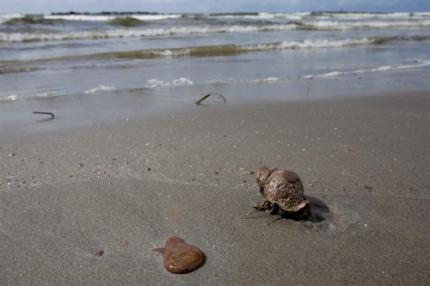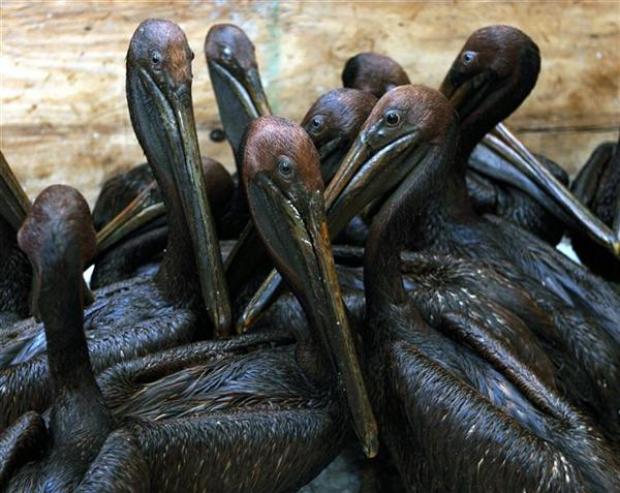Unlike these pelicans, hermit crabs are less obvious victims of the Deepwater disaster (proper crab imagery below the fold, honest) © Magan/Greenpeace
John Hocevar, team leader of the oceans campaign at Greenpeace USA, is currently in Louisiana helping with Greenpeace's response to the BP oil spill. Here's his latest report from the centre of the ever-growing disaster.
Greetings from Grand Isle, Louisiana, one of the growing number of places unlucky enough to win a "heavily oiled" classification on the government maps tracking the disaster in the Gulf of Mexico. Despite BP's efforts to keep it under wraps, we're here to document the impacts of the spill. The public has a right - and a responsibility - to know the true cost of our continued reliance on offshore oil, and fossil fuels in general.
Yesterday, we saw part of the evidence of that cost. Walking through Grand Isle State Park, we came across a tidal flat that was littered with tens of thousands of dead hermit crabs. It was a depressing scene, and took me all the way back to my first visit to the beach, over 35 years ago, when discovering hermit crabs at Rocky Neck State Park in Connecticut helped inspire a life-long love of the ocean.

Now, I realize it can seem a little odd to wax poetically about hermit crabs when we're talking about the biggest environmental disaster in North American history. As John Stewart pointed out on the Daily Show, entire communities along the Gulf Coast are reeling right now, and many species - sea birds, turtles, and even a population of sperm whales - are being pushed to the brink of extinction. Why should anyone care about a few hermit crabs?
The problem is that it's all connected. Hermit crabs may not be quite as cute as sea turtles or as strikingly beautiful as roseate spoonbills, but they are a bellwether for the health of the Gulf of Mexico. Hermit crabs stay largely out of site, eking out a living in sandy and marshy sand and mud. When the sediment fills up with oil, so do the shells of the hermit crabs, and they suffocate.
So if all the hermit crabs on a beach die, it's pretty safe to say that the entire top layer of sand is full of oil - and no longer able to sustain life other than bacteria.
And it doesn't stop there, because hermit crabs are an important part of marine food webs, particularly in the Gulf of Mexico. Shore birds like spoonbills, egrets, and herons feed heavily on hermit crabs, and so do nurse sharks, flounders, and many other types of fish.
Whether they feed on oiled hermit crabs and are poisoned by the toxic mix of oil and chemical dispersants or go hungry because large portions of their food supply have succumbed to this disaster, the impacts of the hermit crab die off we saw last night don't end with the hermit crabs.
The true cost of oil doesn't end at the gas pump.


